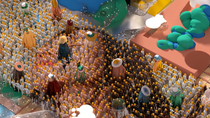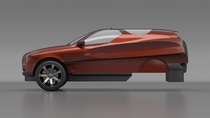Media
What will car colors look like in the future?

Each year, designers for BASF’s Coatings division create a new collection to inspire automotive designers around the globe. The 2022-2023 collection is called NEW ARRAY, providing innovative shades with an increasing focus on sustainability and functionality.
At the same time, the collection moves into new and exciting color spaces that reflect on the transition between the virtual and the physical reality, and the in-between spaces where values and priorities are changing.
The liminal state, the inspiration behind New Array
From banking to shopping, transportation, and food delivery, many day-to-day activities are digital.
Virtual reality is steadily becoming a part of life, with its own set of rules and values in a parallel space. The distance between material and non-material realities is shortening.
NEW ARRAY is inspired by this liminal state, where nothing is certain, and everything is constantly evolving and changing. Think of it like an escalator. It’s a space in-between two different levels, and while you are on it, you don’t belong to either one.
The collection, which includes 45 new colors, looks to “create a diversity of timing and potential for what may happen in the automotive realm,” explains Elizabeth Hoffman, Head of BASF Automotive Design for the Americas, and part of the group of global designers in charge of identifying automotive paint color trends.
This international team of designers from ACT tries to imagine the future for its customers, the automakers. “What we aim to do is not only introduce new colors or even feasible options in the near term, but we're also thinking a lot about future trends, societal trends, and even possibilities for the future, outside of color, just in terms of what the world might look like in the future as a whole,” Hoffman remarked.
We are quickly moving between the physical and the digital, with ups and downs along the way.
Behind the Scenes: How color trends come to be
The ACT team is constantly collaborating throughout the year, whether its members meet virtually or in person. “We have a preliminary meeting to identify what are the key topics, not even necessarily trends, but topics within our team that we might want to work on,” explains Hoffman.
The designers refine those topics and determine what trend signals they see, which guides them to create colors that will dazzle and inspire the automakers.
Each collection is built cohesively around a central theme, and surrounded by specific trends, each one with its own set of characteristics. From there, each regional designer interprets the particulars for the region, evolving the general feeling into key colors.

Key colors for the different regions.
What makes the American customer so unique: Visions of Progress
Our lives are in continuous evolution, more so now than ever, and the future is uncertain. The pandemic has had a serious impact on our way of life, accelerating many of the changes that were slowly approaching. Our wants and needs transformed overnight.
That feeling led to a collection of colors for the Americas called “Visions of Progress.” It reflects the pull from different directions American society is experiencing, shifting values and priorities. “Dealing with a plethora of emotions and conditions associated with both individual and communal identities, one may find solace and acceptance in this space,” explains Hoffman.
The wide range of emotions that comes from experiencing this liminal space led designers to choose “Lava” as the key color for the Americas region. It’s a timeless charcoal gray with effects pigments that produce a red glow when hit by sunlight. It’s natural and simplified, yet sophisticated.
When it comes to car paint colors and vehicles in general, American customers have very specific tastes. As Hoffman indicates, wide-open roads lead car buyers to bigger vehicles. “When you look at the vehicles predominantly driven in North America, you think about pickup trucks and SUVs. Our color designs are often inspired by those body styles. Not every color works for every vehicle.”
The open spaces, the infrastructure of public transportation, traffic, and parking, also are what differentiate the Americas market from Europe, Asia, or South America. "The vehicle is an extension of your identity and personality. Many people want to celebrate who they are, separate themselves from others with their color choice,” Hoffman reflected.
This research is shared with BASF’s customers, the automotive designers, to drive future mass production plans. You may see Lava or any of the other ACT key colors on the road in 3-5 model years.
To learn more about the New Array collection, visit BASF’s Coatings website.
To learn which colors are more popular, check out BASF’s annual Global Color Report, published in January. Access the latest Color Global Report
Published on November 15, 2022, by Mariana Licio.
For media inquiries or to repurpose this article, please contact Lisa Brown.
